- Home
- Technology Groups
- Competence Center for Micro- and Nanotechnologies
- Research results
- Single Microwave Photon Detection
Single Microwave Photon Detection

23.04.2018
Modern technologies are expected to benefit from quantum effects, such as entanglement or uncertainty, and a technological revolution is expected to ensue upon their implementation. One important key technology is the detection of single microwave photons. We developed a concept for its realization, experimentally investigated a prototype device, and are now investigating its potential for applications.
By: Gregor Oelsner // Evgeni Il’ichev // Uwe Hübner
Modern quantum technologies have attracted a growing interest from industry and science in the past few years. In contrast to first-generation quantum technologies (e.g., lasers, single electron transistors, atomic clocks, and superconducting quantum interference devices), the new generation is expected to exploit important quantum effects (e.g., entanglement, superposition, uncertainty, and the manipulation of single or ensembles of quantum objects). The interest of large tech companies such as Google or Intel focuses on quantum computing with possible applications for big data analysis, machine learning, and artificial intelligence. Here, superconducting quantum systems are considered a technological basis because they benefit from good controllability and scalability, as well as a high level of integration.
In fact, a large number of macroscopic quantum effects has been observed on such superconducting circuits, the basic elements of which can behave both as quantum bits and artificial atoms. For their effective handling a variety of experimental techniques at microwave frequencies has been developed. Still one important key technology, namely the detection of single microwave photons, is not yet available.
We demonstrated a new possible detection concept to overcome this obstacle. It is based on a single biased Josephson junction that shunts a coplanar waveguide resonator. The hysteretic current-voltage characteristic of the junction enables the detection of the small current oscillations produced by the photon inside the cavity; in addition, it ensures the dissipation of the photon after detection. The detection is, therefore, represented by a switch of the junction from its zero state to its finite voltage state. A unique feature of the proposed method lies in the detection process. While standard photon detectors are based on energy transfer by exciting higher energetic states, our concept can be theoretically discussed within the framework of the modulation of the junction’s potential. Therefore, in addition to the straightforward application on photon detection, an experimental characterization can provide new basic insights into the nature of quantum measurements.
In a first experimental analysis [1], the dynamics of such a prototype device were tested. The circuit is created at Leibniz IPHT by well-established methods for the fabrication of sub-micrometer sized Josephson junctions [2]. It may be noted that for the observation of quantum effects in such superconducting circuits, such small-scale junctions are an essential requirement. Also, the same fabrication technique allows for directly embedding the detection of single photons into the quantum circuit.
In the experiment [1], the detector is characterized by determining the switching current histograms for various control parameters. This includes the frequency and amplitude of a microwave signal applied to the cavity as a test signal and temperature. In contrast to research that has already been carried out on isolated Josephson junctions, the latter also affects the population of the cavity modes. Thus in the experiment, unusual temperature dependencies for the mean switching current and its distribution have been observed (see Fig. 1).
As briefly mentioned above, an applied microwave signal produces an RF current inside the resonator and at the Josephson junction. This current depends on both the applied microwave power and its frequency because of the resonance condition within the cavity. The latter is modified by the bias-dependent, non-linear characteristic of the Josephson inductance. These combined dynamics lead to a variety of different shapes for the switching current distribution for different experimental parameters. Example curves are presented in Fig. 2. They demonstrate different features expected in theory, such as narrow distributions for large amplitudes, spiky characteristics, an unusually-shaped distribution, and dynamic bifurcation.
To estimate the potential of the detection concept described for optimal microwave frequencies, the microwave amplitude is further decreased. The applied power, together with the design of the sample, allows an estimation of the mean photon number inside of the cavity. We have demonstrated that the sensitivity parameter (see Fig. 3), defined as the shift in the mean switching current divided by the width of its distribution, still reaches 0.5 at the level of a single mean photon inside of the resonator. At above ten mean photons, this sensitivity is above 80%. In addition, a direct proportionality between the shift in the mean switching current and the applied microwave amplitude was found. This supports the unique measurement process and promises interesting dynamics when detecting non-classical states of light.
Further work is required to improve the sensitivity or to clarify whether 0.5 is a fundamental limit. Also, we plan on determining the quantum efficiency of an improved device. For optimal quantum efficiency, it would be necessary to reduce the width of the switching currents and improve the input coupling of the cavity or to produce single-photon states inside the resonator. A multiplexing scheme allowing the detection of the color of the input photons and an improvement of the biasing and readout circuit for the junction with the aim of real photon counting are also both imaginable.



